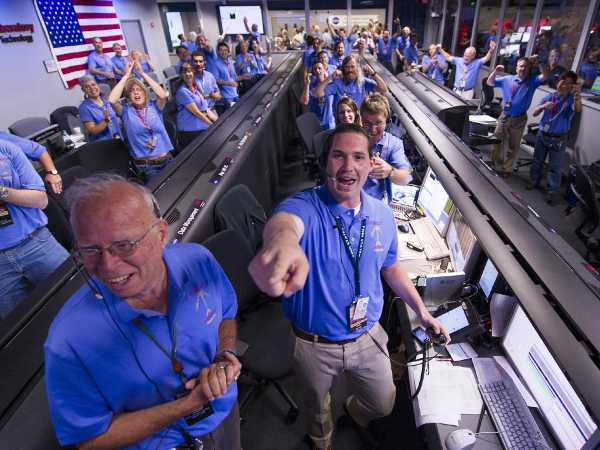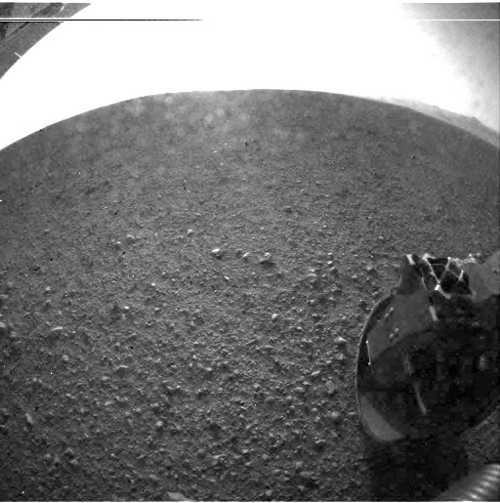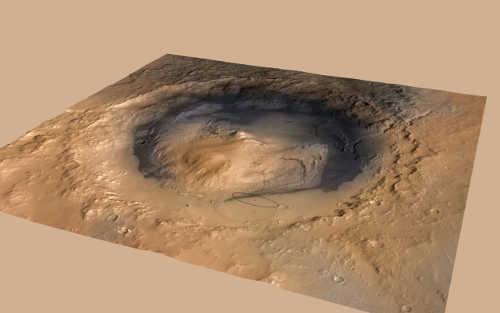
A mission to Mars that has inspired millions of people the world over took its next big step on Sunday night when the Curiosity rover touched down on Mars.
The rover – launched in a spacecraft last Nov. 26 from Cape Canaveral Air Force Station in Florida – landed at approximately 10:32 p.m. Sunday, the Mars Science Laboratory team reported.
Viewers around the world watched the team track the rover through its landing, dubbed the “seven minutes of terror.”
Several Lake County residents reported on Facebook that they watched NASA’s online stream of the team as it got the good news, with the blue-shirted team members breaking into cheers, hugs and high fives.
The one-ton, car-sized Curiosity is the most advanced rover ever built, and was made in the United State, according to the National Aeronautics and Space Administration.
The mission has cost an estimated $2.5 billion, which NASA officials said breaks down to about $7 for every U.S. citizen.
NASA Administrator Charles Bolden said the rover “will seek to answer age-old questions about whether life ever existed on Mars – or if the planet can sustain life in the future.”
President Barack Obama called the landing “an unprecedented feat of technology that will stand as a point of national pride far into the future. It proves that even the longest of odds are no match for our unique blend of ingenuity and determination.”
Obama added, “And tonight’s success reminds us that our preeminence – not just in space, but here on Earth – depends on continuing to invest wisely in the innovation, technology, and basic research that has always made our economy the envy of the world.”

Hanging by ropes from a rocket backpack, Curiosity touched down in Gale Crater, at the foot of the the three-mile-high Mount Sharp, the geological layers for which are the mission’s prime destination.
NASA said observations from orbit have identified clay and sulfate minerals in Mount Sharp’s lower layers, indicating a wet history.
Minutes after the landing, the jubilant Mars Science Laboratory team members began receiving the rover’s first views for Mars, shots taken from a fisheye camera showing the planet’s surface.
Adam Steltzner of NASA’s Jet Propulsion Laboratory in Pasadena, leader of the team that developed the system for Curiosity – which he said was named for the “defining human attribute” – later told reporters that the rover appeared to have had an “extremely clean” landing.
Steltzner said he was “terribly humbled” by the experience of the rover’s landing, crediting the team he led with accomplishing the feat.
John Grotzinger of the California Institute of Technology in Pasadena, project scientist for Curiosity, said more than 3,500 Jet Propulsion employees took part in the effort, which also included nine principal investigators and the work of seven additional countries – Germany, France, Spain, Russia, Denmark, Britain and Canada.
Grotzinger noted the mission’s importance in promoting the sciences for younger generations.
“There is no greater inspiration for middle school children that are going to math, science and engineering than a mission to Mars,” he said, adding that the number of hits on the mission’s Web site is “unparalleled.”
At a time when many may question the wisdom – and cost – of going into space, Grotzinger said the mission cost to every United States resident equals the cost to go to a movie. “That’s a movie I want to see.”
Curiosity is the third Mars rover, after Spirit and Curiosity. The latter continues to actively study the red planet eight years after its arrival, NASA reported.
During a nearly two-year prime mission, Curiosity will investigate whether the region ever offered conditions favorable for microbial life, NASA reported.
NASA officials said Curiosity carries 10 science instruments with a total mass 15 times as large as the science payloads on the Mars rovers Spirit and Opportunity. Some of the tools are the first of their kind on Mars, such as a laser-firing instrument for checking elemental composition of rocks from a distance.

Curiosity will use a drill and scoop at the end of its robotic arm to gather soil and powdered samples of rock interiors, then sieve and parcel out these samples into analytical laboratory instruments inside the rover, according to NASA.
But NASA officials said early Monday that they plan to take their time as they begin exploring Mars with the rover.
Grotzinger said they will spend a few weeks checking things out before taking a drive, and plan to spend several months using all the instruments. In a year or so they could be on the base of Mount Sharp.
“The mission’s about patience and checking things out carefully,” said Grotzinger.
Richard Cook, the mission’s deputy project manager, compared it to a family vacation and driving from California to Chicago, but instead of your family you have 400 scientists who want to stop and look at interesting things along the way.
Peter Theisinger, director of the Engineering and Science Directorate at the Jet Propulsion Laboratory and the mission’s project manager, said he didn’t think anyone would be shocked if it lasted twice the estimated two years.
“We’ve got a long mission ahead of us and because of that and the capabilities of this rover, we have the possibilities for just monumental science accomplishments,” he said.
He added, “We’re in no hurry.”
Curiosity is a “priceless national asset,” Theisinger said, “and we are not going to, pardon the French, screw it up.”
Theisinger said they will take their time in rolling out the mission. He guaranteed it will be done at a slow, deliberate, methodical pace, and asked people to be patient.
Stay tuned – NASA officials guaranteed new discoveries every day thanks to the mission. Later this week new, bigger color picture are expected from the rover once its mastcam is active.
Follow Curiosity’s journey at http://mars.jpl.nasa.gov/msl/ , on Twitter at www.twitter.com/MarsCuriosity or on Facebook at https://www.facebook.com/MarsCuriosity .
Email Elizabeth Larson at

 How to resolve AdBlock issue?
How to resolve AdBlock issue? 



